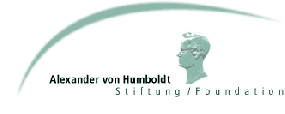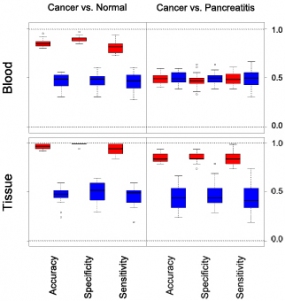Blood-based microRNA Diagnostics
- Blood-borne microRNA signatures in human pathologies
- MicroRNAs in the blood of patients with primary CNS lymphoma (PCNSL) act as prognostic biomarkers
- Diagnosis of pancreatic ductal adenocarcinoma and chronic pancreatitis by measurement of microRNA abundance in blood and tissue
- MicroRNA signatures of peripheral blood cells in humans infected with Trypanosoma brucei gambiense
- MicroRNA expression profiles in peripheral blood cells of rats infected with Trypanosoma congolese and Trypanosoma brucei subspecies

The balloon plot shows in how many diseases microRNAs are up- or down-regulated. The bubble size represents the number of microRNAs showing the respective distribution of up- and down-regulation. Orange bubbles represent microRNAs that are predominantly down-regulated, while blue bubbles stand for predominantly up-regulated microRNAs. The two green bubbles represent 9 microRNAs that were equally often up- and down-regulated in disease.
© dkfz.de
Beyond studies that describe microRNAs frequently as markers for specific traits, we asked whether a general pattern for microRNAs across many diseases exists that could act as an intial, non-invasive means of diagnostics. In a multicenter study, we evaluated circulating profiles of 1,049 patients suffering from 19 different cancer and non-cancer diseases as well as unaffected controls. The results were validated on 319 individuals from three different centers using qRT-PCR. We detected consistently deregulated profiles for particular diseases; pathway analysis confirmed disease association of the respective microRNAs. Overall, we discovered 34 miRNAs with strong disease association. In addition, a set of microRNAs was discovered that act as rather stable markers, offering reasonable control microRNAs for future studies. Our study further underscores the high potential of specific blood-borne miRNA patterns as molecular biomarkers.
Publications:
Keller et al. (2014) BMC Med. 12, 224.
Keller et al. (2011) Nature Meth. 8, 841-843.
MicroRNAs in the blood of patients with primary CNS lymphoma (PCNSL) act as prognostic biomarkers
Despite improved therapeutic regimens, primary CNS lymphoma (PCNSL) remains a therapeutic challenge. We characterized by next generation sequencing the microRNA fingerprints in the blood of PCNSL patients enrolled in a large randomized phase III study, comparing short-term to long-term survival. Twelve microRNAs were significantly deregulated between the two groups. The microRNAs miR-493-3p and miR-432-5p exhibited the most prominent differences. Furthermore, we identified short RNA molecules with putative microRNA function that had not been described before.
Publications:
Roth et al. (2015) Eur. J. Cancer 51, 382-390.
MicroRNAs can regulate hundreds of genes post-transcriptionally and appear to regulate virtually all cellular processes. Owing to these properties, microRNAs have a critical role not only in physiological but also in pathological processes. There is meanwhile a lot of evidence that miRNA profiles from body fluids, such as blood, and informative about the disease status of a blood donor.
A detailed analysis of microRNA profiles was performed for pancreatic ductal adenocarcinoma. A solid diagnostic process could have substantial impact on the successful treatment of the disease, for which currently mortality is nearly identical to incidence. Variations in the abundance of all microRNA molecules from peripheral blood cells and pancreas tissues were analysed. In total, 245 samples from two clinical centers were studied that were obtained from patients with pancreatic ductal adenocarcinoma or chronic pancreatitis and from healthy donors.
Thee blood test demonstrated very high sensitivity and specificity of a distinction between healthy people and patients with either cancer or chronic pancreatitis. Confirmative and partly even more discriminative diagnosis could be performed on tissue samples. In addition, discrimination between cancer and chronic pancreatitis was achieved. Several miRNAs were identified that exhibited abundance variations in both tissue and blood samples.
The results could have an immediate diagnostic value for the evaluation of tumour reoccurrence in patients, who have undergone curative surgical resection, and for people with a familial risk of pancreatic cancer.
Publications:
Bauer et al. (2012) PLoS ONE 7, e34151. [PDF]
Human African Trypanosomiasis - sleeping sickness - still affects thousands of people a year. Control relies on diagnosis and treatment, and in the absence of this surveillance, the number of cases rapidly rebounds. Diagnosis relies on an antibody test and microscopy. The type of treatment depends on the disease stage: whether parasites have entered the central nervous system; and this can be determined only by lumber puncture and analysis of cerebrospinal fluid. The development of sensitive, simple and reliable tools for diagnosis and staging of human African Trypanosomiases would significantly ease field surveillance and enhance patient care. We investigated whether the patterns of miRNAs from peripheral blood could be used to decide whether patients are infected, or to determine the disease stage. We found that the miRNA patterns did differ between parasite-positive patients and uninfected controls with no immune reaction to trypanosomes. Also, people with immune reactions to trypanosomes, but no detectable parasites, sometimes showed patient-like profiles. The patterns were not reliable enough, however, to be used for diagnosis.
Publications:
Lueong et al. (2013) PLOS ONE 8, e74555. [PDF]
MicroRNA expression profiles in peripheral blood cells of rats infected with Trypanosoma congolese and Trypanosoma brucei subspecies

To identify differentially regulated miRNAs during trypanosome infections, we analyzed the miRNA expression profiles of uninfected rats and animals infected with Trypanosoma congolense and different Trypanosoma brucei species. The potential target genes of the regulated miRNAs as well as their biological pathways and biological functions were investigated.
Publications:
Simo et al. (2015) Microb. Infect. 17, 596-608









